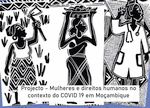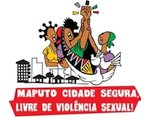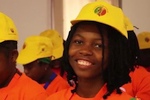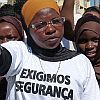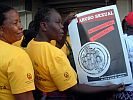The Case of the 2004 Legislative Elections in Mozambique.
A Gender Analysis
Conceição Osório1
The legislative elections held at the end of 2004 were the corollary of the first ten years of establishing a democratic system in Mozambique. The political participation of citizens in a multi-party context during that time allowed not only the extension of the range of choices by the electorate for the exercise of executive and legislative powers, but also the creation of new and diversified possibilities for political participation by citizens. Democracy allowed the discussion of a new range of problems, by contributing to the multiplication and diversification of choices and political inclusion, thus ensuring that there is a plurality and diversity of voices and ways of thinking.
In this context, a growing number of women have been taking their place in decision-making bodies, both within the public administration and at the level of political power, especially within political parties, the Assembly of the Republic and the government. The presence of women in public spaces has thus allowed skills and competencies to become visible such that they might, on the one hand, be a factor in dismantling the social representation of the traditional roles of women, and on the other, be a factor for positive change in the law and public policies in the defence of the human rights of the socially excluded.
Ten years on from the introduction of political democracy in the country, this research is intended to identify the changes brought about by the pluralist system in women’s access to political power, both in terms of the possible break away from the social model of male domination and of the expectations that the exercise of power may create. A study of the 2004 legislative elections allows an analysis of the way in which the mechanisms that establish the structure and hierarchy of the political parties are susceptible to the change that the presence of women in political life could bring about.
The units of analysis of the study are the political parties PIMO, PDD, FRELIMO and RENAMO and the target group is the women and men who appear on the lists of candidates. The hypotheses of the study are:
- Women’s access to the candidate lists of the political parties in the 2004 elections is governed by the global context that recognises the need to make the presence of women visible, on the one hand, and on the other, constrained by models of socialisation.
- The representation of political power by women and men candidates is affected by the logic of male domination and may reveal differing expectations of the exercise of political power.
The geographical areas of the study were the Voting Districts of Maputo city and province and Nampula and Sofala provinces.
The observation instruments used were semi-structured interviews and monitoring forms for broadcasts on TVM, rallies and other election campaign activities of the four parties. The content of the programmes and charters of the political parties and of the print media was also analysed.
The fieldwork was carried out over 40 days, during which time we conducted 94 interviews, observed 39 rallies and marches and watched 41 hours of television broadcasts. We also analysed 67 editions of a daily newspaper and two weeklies.
The criteria of analysis of the various instruments of observation were access to political power, social representations, relationships of power and the exercise of power.
The programmes, charters, election manifestos and speeches of the political parties
The programme documents on the mechanisms of access by women to power and the roles assigned to them are different, not only between the political parties, but also between bodies within the same political party. With the exception of FRELIMO, the parties express no clear strategy in their programmes and charters of commitment to political participation by women. It was evident from the documents we analysed that the participation of women is not a central issue for the political parties in deepening their internal democracy, that is, even where there is some reference to increasing the political visibility of women, this is not reflected in the composition of the party structures nor in the speeches of their leaders.
The same situation is revealed in the lists of candidates presented for the 2004 elections, where only two parties (FRELIMO in five voting districts and PIMO in one) presented lists headed by women.
Meanwhile, if we analyse the documents issued by the women’s organisation of the parties (only FRELIMO and RENAMO drew up strategies), we find no similarity between the ideology of the two parties, as expressed in their programme and manifesto, and the objectives of their women’s organisations. For example, the Organisation of Mozambican Women (OMM) does not include in its programme objectives the principles of gender equality proclaimed by the party of which it is a part. In contrast, the Women’s League of RENAMO, although it also defends the idea of strengthening the traditional roles of women, introduces strategies that signal a clear intention of the defence of the human rights of women.
However, considering the differences noted, the similarities among the positions of the parties are greater than their differences: gender equality is not regarded as a precondition of the development and deepening of the democratic system in any of the principles expressed in the documents of the four parties. In the same way, any references to women in the issues identified as priorities for government action appear in a disjointed way and without any grounding in assumptions of equality. At the same time, the intervention of the party-related women’s organisations in the party’s access to power is irrelevant, notably in the composition of the candidate lists in the 11 voting districts, and it is limited mainly to providing bonds for the lists of deputies to the Assembly of the Republic.
Because of its coverage, broadcasting is a very important tool for publicising political party programmes. However, an analysis of broadcasts allows us not only to identify party intentions, but also, and more importantly, to read between the lines and discover the ideology underlying their discourse. As regards women and their role in the democratic system, the political parties in general base women’s political participation on the maintenance of a model that represents them more as the object rather than the subject of political activity. With a few exceptions, much of the discourse on women (there were only 11 references to women in 41 days) highlights the paternalistic bent of the political parties and their leaders, on the one hand, and the victimisation of women, in the sense of their “essential” vulnerability to the female condition, on the other.
These positions were consistent with speeches made at rallies and marches held during the election campaign. Only eight of the 39 rallies and other campaign activities observed were led by women, but it was noted that women by far outnumbered men in the marches and door-to-door canvassing of all the parties in four voting districts. This difference in women’s participation in the day-to-day campaign activities is largely due to using women’s capacity to mobilise and their willingness to take on the less visible work.
There was therefore no recognition by party leaders of the need for equity in campaign management, mainly with regard to leading the activities considered more important, as in the case of rallies. In most of the large public meetings, the role of the women was limited to singing and urging people to vote for their leader and their party. At the same time, men made 90% of the references to women’s rights. Most of the speeches by women, even women in senior positions in the public service or party structures, emphasised the virtues of the leadership and their role in improving the lives of ordinary people. This apparent contradiction between having large numbers of women active in the campaign and the lack of awareness of gender inequality in access to resources was very strong in the campaigns conducted in areas where the access of girls to school is culturally constrained, there is no health post or maternity unit and women have to walk for miles to fetch water. We think that this situation, in which women are ignored, cannot be explained simply because it was election time, but mainly because of persistent and sustained social and political discrimination against women in this country, where poverty, disease and illiteracy have women’s faces.
The representation and exercise of political power by women
The speeches on the significance of power made by women candidates are marked by the presence of two issues that are apparently in contradiction: on the one hand, the representation of power as “service to the party”, and on the other, an identification of power with awareness of real problems capable of creating differences.
The coexistence of a concept in which the political field still requires a series of dispositions that women do not possess, with the inclusion of an ever-increasing number of women in political activity, simultaneously produces behaviour and discourse that, on the one hand, expose the inadequacy of politics to incorporate new ways of thinking and of exercising political power, and on the other, may “make the difference”, both in terms of the representation of and of the exercise of power. However, this difference has not yet been established as a new model for the exercise of power, not only because of resistance in the political sphere (as regards its values, structure and hierarchy), but also because of interaction with other spheres that constitute a certain social and cultural model. This means that the social control exercised over women, establishing their roles and social functions, is projected on the political domain, albeit with contradictions and uneasiness.
Two dominant trends in the representation and exercise of power by women were found in the analysis of the speeches made. The first trend maintains that women in power are notable for their qualities of tolerance, honesty and a capacity to listen to and resolve real problems, unlike the men who exercise power, who are considered to be “more corrupt, more authoritarian and more ambitious”. The second trend stresses that the party, which is perceived as an entity beyond interests and conflicts, gave the power. Curiously, this discourse of conformity with and acceptance of male domination runs parallel to the discourse that rejects the need for women to win and transform power.
We also identified a third trend, which encompasses a very small number of women in the candidate lists who have naturalised submissiveness within the party, regarding “domesticity” as the principal disposition of women and adopting similar mechanisms of subordination in the political sphere to those that shape their relationships within the family.
As regards male discourse on the representation and exercise of power by women, two trends dominate: the majority, who emphasise the notion of power as being naturally male (perceived as “command” and “authority”), and that it was granted to women. Although the political activity of women is classified as positive (mobilising, tolerant) the majority of the men in the opposition parties perceive the inclusion of women in politics as complementary, in the sense of being subject to guidance by the party, which, in the discourse of candidates, is confused with the role of men. That is, since men possess the disposition that defines the nature of politics, the participation of women in politics must be confined (according to the respondents) within the limits imposed by and expressed in the mechanisms through which the exercise of political power functions and is structured. What this means is that, by characterising women as tolerant, participatory and convincing, and simultaneously as timid, anxious and emotive, the candidates apply what they regard as the characteristics of politics (power of decision, debate, aggressiveness and the capacity to “go all the way”) to their representation, while excluding those that show them as different. For this group of men, women’s participation in politics thus has a utilitarian sense, in that it not only legitimises political control, but also lends legitimacy to the control exercised in other fields.
The second trend is characterised by discourse of equality that highlights discrimination as being a result of constraints on access to education, although it does not question the cultural model. While the candidates in this group offer politically correct discourse, which shows that they are familiar with the general demands for equal rights, they stress the role of female complementarity, transferring the parts they regard as being essentially female in nature, such as “caring” for others, to the exercise of power by women.
The problem that arises in this trend is not the appreciation of the difference or of the specific nature of the female experience, but the fact that these are represented as secondary and complementary to political life. This hierarchy in politics of the “more lofty issues” of the “professional” men and the “more lowly” of the “amateur” women leads us to question such discourse and consider it discriminatory and exclusionist.
Social gender relations as relations of power
When we study relations of power, the central issue is to understand the mechanisms for the integration of women into political parties and to identify the possibilities for acting on these. In other words, we need to find out how the appearance of these players on the political field can deactivate both the control mechanisms (appeals to the social role of women) and the strategies against domination/resistance, such as the legitimisation of the “feminisation” of political action (caring for others).
It was clear in about 90% of the speeches by women candidates from all political parties that the imbalance in the distribution of resources and tasks among the candidates (such as leading rallies, talking to the media, the circulation of privileged information) was organised around (although not only) gender discrimination. While access to resources was not dependant solely on the inequality between men and women, the structure of inequality was the argument most often used by women to express their difficulties in access to and the exercise of power. This means that, even in the parties that make systematic appeals to the supreme values of the party to mask the conflict, the discourse of the majority of women candidates is laced with the realisation that the social model constrains political action. However, this observation of the constraints contained in the social model often clashes with women’s “conformity” to domination, either because they represent subordination to men as “right” or because the model of domination is sometimes masked, as in cases where women adopt male values and practices in the exercise of power in order to be accepted into this power structures.
Unlike the majority of the women, the men interviewed always referred to the party as an organisation that includes national interests, without questioning the mechanisms for access to power.
About 90% of them acknowledge the discrimination that exists in the relations of power between men and women, which is expressed both in the occupation of places in the decision-making bodies and in the composition of the lists. However, the candidates regard this inequality as natural, that is, the fact that women do not have the same opportunities as men is because of factors related to the “essence” of the female identity. While recognising that women have capacity for political mobilisation, the respondents do not allow them the competence to be included on an equal footing in the “world” of party politics. Two types of argument are put forward in defence of this position: firstly, because of the “hesitant nature” of women, they are not capable of taking decisions, and are therefore not cut out for the exercise of political power; secondly, women exclude themselves in a way by the very priorities they define for their lives (the family). Thus the political model is cleared of any guilt for the lack of attraction felt by women towards the exercise of power.
By viewing the family and political spheres as being in contradiction with each other, the candidates reinforce the legitimacy of politics being a field where positions differing from or alternative to the dominant interests are excluded. In other words, by rejecting the possibility of encompassing new ways of thinking and living politics, male discourse negates the possibility that the political parties might embrace multiple interests and limits the democratic system to a single model of political participation. This is not only distortion of the system precisely by one of the instruments (political parties) that best expresses it, but utilisation of the system to negate it, insofar as it includes women (provided that they assume the role acknowledged as legitimate).
It is interesting to observe that, faced with a challenge to their control by some women candidates, male discourse frequently resorts to African culture, not only denying women their right to equality, but also blaming them for the ills caused by breaking away from social values and rules.
In the interpretation of the relations of power, we see that the differences existing between the party candidates is more a result of the domination of “modern” discourse on gender equality than a conviction that the present relations of power are the result of the transposition of a structure of inequality on to the political parties and expressed, for example, in the way resources are not only distributed but also classified as such. That is, the availability of women for political activity during the election campaign, their demonstrated capacity to communicate with ordinary people and their going to and fro between residential neighbourhoods and markets were not acknowledged (either by the men or women candidates) as being fundamental in the dissemination of party messages. Greater access by men to vehicles, the “megaphone” and large gatherings of people in the campaign was a clear sign of power, reflected in the monopoly of campaign strategies by the leaders.
A perception is beginning to appear in some male discourse that the reasons underlying gender inequality are to be found in the social model that maintains and perpetually reproduces the structure of discrimination. We felt the need to investigate this issue further: how is the representation of gender discrimination expressed by these new male positions constrained by the dominant model (as regards access to power, for example) and what are the strategies adopted for the transformation of politics and, naturally, the democratic system. That is, it would be interesting to understand how a position of party leadership in the present mould is reconciled with the inclusion of new mechanisms for the exercise of power.
Conclusions and recommendations
The increase in visibility of women’s political participation in Mozambique (still far from corresponding to the demographic distribution of the population) and the maintenance of the mechanisms of how politics works have been the subjects of this research. That is to say, this work has sought to identify the motivation, the constraints and the context that allow or prevent women’s access to power, as regards political representations and praxis. Taking sex as a variable, our intention was to understand, in the concrete case of the subject of this study, how the differences in access to, the representation of and the exercise of power express the ways in which biological sex is socially constructed by men and women and supports the naturalisation of gender inequality.
Although the information is presented under separate subject headings, we have sought to cross reference the different types of information in order to show any unique features that might point to the emergence of new components in political representation and activity. The analysis of the interviews with candidates was put into context, whenever possible, within the programme documents produced by the political parties.
As regards access to politics, it was found that the logic of including women may still be explained by the political need for visibility, and the political participation of women is not understood as a factor in the deepening of the exercise of democratic power (or it is understood within the framework of legitimising the role of woman as provider). The motivation for the political participation of the majority of the women thus lies in the logic of the continued representation of the role of women as mother, or, in contrast, it conforms to the present model of power. In both cases, the women do not question the “possibilities” open to them, but are in power either as consumers of the discourse and mechanisms of male control, or they adopt such mechanisms and discourse in practice, and only in this situation can they be subjects.
Meanwhile, this study found that positions have begun to emerge among a certain group of women challenging the way in which the political parties include them in political life. These positions were expressed in the rejection of the secrecy and lack of transparency surrounding the composition of the candidate lists, in the definition of new criteria for the distribution of resources and in the development of strategies against domination, such as the circulation of information regarded as available only to the political bodies of each of the parties.
These women have begun to perceive that the inequality between men and women is structural in the social model, that the mechanisms for establishing hierarchies in the parties and the way they function reflect the existing constraints in social relations produced and developed within the family. They have further begun to understand that the male monopoly of the world of politics, although organised and supported differently, is present and defines the structure of all social space. This situation is even more interesting when politics tries to set itself off as neutral, unlike the family; an example of this is the authoritarian use of the competency of the hierarchy, which is intended to be distinguishing and classifying. The exclusion of women, as beings with a different kind of experience, in fact serves to diminish the democratic system. This is even more curious if we take into account the fact that we are dealing with access to parliament, which should be the most excellent instrument and place of democratic practice.
As regards women’s political participation, the tensions and conflicts running through politics are reflected in the discourse on party programmes and in the contradictions that riddle the documents produced, the composition of the party bodies and the control of resources, as became clear during the observation of the election campaign (although the model tried to hide them or treat them as irrelevant).
With the exception of the FRELIMO party programme, most of the documents from each of the parties mirror the representation of women’s political participation in a context of vulnerability and complementarity, that is, the role of women in the parties cannot bring about structural changes (because the model is “good” and “fair”) and must be complementary to male political activity. This means that women must practice in the political field that which is a biological impossibility for men: motherhood. This idea of complementarity, by not challenging the continued superiority of the political model, is naturally perceived by men as the right way for women to be involved in politics. The same is true of the question of vulnerability: assuming that women are vulnerable, in the same way that the poor and the disabled are, gives them a status of dependency, denying them a role as subjects of political activity.
This representation of women’s political participation, common to the party programmes, is also visible in other documents, namely those prepared by the women’s organisations of the parties and the election manifestos. Even where the programme explicitly expresses a policy of gender equity, as in the case of FRELIMO, the strategy of the women’s organisation has a philosophy of acceptance of an inferior role, visible in its conformity to the role given to them.
As regards male discourse on women’s political participation, it became clear that the great majority of the respondents consider the exercise of political power by women as a continuation of their role in the family; in fact, for many of them, the legitimacy of women’s involvement in politics lies precisely in either the “essence” of the female condition, or, in contrast, the fact that some of them deny this very condition. This means that the political inclusion of women is accepted by the majority of the men in two situations: one in which the women reproduce in political life the social roles they play in the family, and the other in which women behave according to the parameters set by the model, as is the case with some senior figures in the public service.
However, these conclusions should not be understood in a linear way, man/woman in opposition, but rather in the context of the tensions that develop in politics. At the same time, it was found that a new male discourse is emerging, without going into this in any depth. This new discourse stresses the need for women to include new elements in the exercise of power, not only in the sphere of discourse, but also in the sphere of creating new aims for the world of politics. In it, the men question the incapacity of their female party colleagues to demand more rights and take possession of gender inequality.
In the light of these findings, recommendations are made in regard to training and to relations with civil society and the research community, with the aim of creating gender awareness among women deputies and enabling them to draw up a common parliamentary agenda.
Over the last 10 years, some organisations have carried out training for women deputies in the Assembly of the Republic. This training has sought to provide them with new skills, mainly in relation to leadership, enabling them to improve the quality of women’s involvement in parliament. We think that this work should continue, although we stress that the women need to identify the factors in the social construction of gender inequality that prevent them from participating on an equal footing with men.
This means that the women deputies must themselves be in charge of their own acquisition of skills, organising and cataloguing their experience as women and as politicians, so that they can acknowledge their right to have new aims and discourse integrated into parliament. What this training should try to do is, as well as dealing with issues of knowledge (such as legislation), to build awareness that can become a factor in defending the human rights of women, without, however, disqualifying them as political agents.
In relation to this aspect, greater involvement by civil society women’s organisations in supporting women MPs is suggested. The isolation/aloofness (or the existence of only formal activity) of some NGOs towards the work of women MPs constitutes a serious brake on qualitative change in the political conduct of women deputies. It is not enough to have female representation in parliament. It is fundamental that this representation is translated into concrete actions in defence of the human rights of women. At the same time, such interaction between organisations and women deputies will allow the struggles for change in the model of political participation to avoid resulting in the exclusion of the women who wage them. This means that the stronger the relationship between civil society and the women deputies, the less chance there is that demands for gender equality can be isolated and/or ignored. The fact that these recommendations are addressed to women in particular does not mean that there should be no activities, both in training and in networking, aimed at involving male deputies in the struggle for a fairer and more equal world.
Finally, we think that research into women’s access to and exercise of political power should continue, notably in the observation of parliamentary practice. Furthermore, we think it is important to include questions that this study left open, such as the representation of the exercise of power by women made by some male deputies, which is in contradiction with the culture of male domination. We think it would be particularly interesting to assess how such positions are expressed within the parties and how they might play a role in changing the way political organisations function.
- Executive summary of the research report on the political participation of women in the 2004 legislative elections, conducted by WLSA.







 Information in English
Information in English